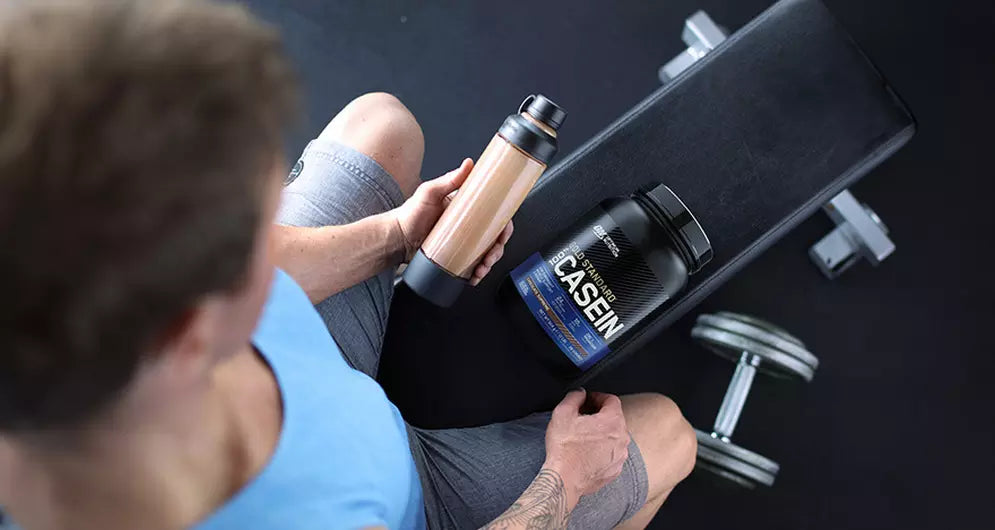Your basic glass of cow’s milk that you might have drank this morning – or even poured on your cereal or oatmeal is about 88% water, 5% carbohydrates, 4% fat and 3% protein. The very popular whey protein makes up about 20% of that with another milk protein called casein providing the other 80%.
Unlike fast-acting whey protein, casein takes much longer to digest. Casein protein powder supplements also mix into a thicker, richer shake compared to the thinner consistency of whey. And a serving of that casein protein powder provides around half the Daily Value (DV) for calcium compared to less than 10% in a serving of whey.
One thing casein and whey have in common is their status as complete proteins, providing the full array of Essential Amino Acids (EAAs) including the three Branched Chain Amino Acids (BCAAs) Leucine, Isoleucine and Valine. EAAs play important roles in muscle building and recovery, and since your body can’t produce them on its own, they must be taken in through foods and food supplements.
A Brief History of Casein
Although casein protein might be relatively “new” to the fitness and supplement industry compared to whey protein, it’s been around just as long.
The earliest recorded use of casein was in ancient Egypt, where casein separated from milk was used as a pigment fixative for wall paintings. Later, casein was used as a component of various glues, and in the early 1900s started to be used as a type of plastic to produce buttons, knitting pins, fountain pen barrels and other items of daily industrialized life.
From Cow’s Milk to Shaker Cup
Whey protein makes up 20% of the naturally occurring protein and casein protein which accounts for the other 80%. In its natural form, as part of milk and the various products produced from milk, the solid curds separated from liquid whey protein in the cheese making process are casein protein. You are also consuming casein protein when you eat hard cheeses, cottage cheese or greek yogurt. Drying solid casein is the first step taken when processing this protein into a powder for use as a supplement.
Although casein protein has long been a component of blended protein powder formulations when milk proteins are used, Optimum Nutrition is largely recognized with introducing casein protein as a single-ingredient protein to the supplement industry in 2004, following up with the introduction of the first micellar casein protein powder in 2005. Why the evolution? The micellar structure of casein is considered the natural structure of casein protein and is perceived as more premium by athletes and those seeking to support muscle building and recovery.
Supplementing With Casein Protein
Casein is a versatile protein that can be a great complement, and not necessarily a competitor or replacement, to whey protein. While whey protein is considered a rapidly digested and often used after exercise or training, casein protein is best used between meals or right before bed, when protein and other nutrients won’t be available for an extended period of time. Because of casein’s slow rate of digestion – potentially up to 6 or even 8 hours, a casein shake can deliver amino acids to recovering muscles for significantly longer than rapidly digesting whey protein. In addition to differences in digestion times, the texture of casein is different than whey as well. While whey protein shakes tend to be thinner and easier to consume quickly, casein is much thicker with a texture like a melted milkshake. That’s the nature of casein protein.
Of course, enjoying casein protein doesn’t have to be limited to mixing the powdered supplement into a shake.
If you find yourself often wanting to satisfy your sweet tooth and your muscles with something much thicker and decadent, try casein mousse or even casein soft serve “ice cream.” You can turn casein protein powder into a thick, rich pudding by mixing a scoop into 5 to 6 ounces (about 177.44 ml) of water in a bowl instead of the recommended 10 to 12 ounces (about 354.88 ml) in a glass or shaker cup. When you mix vigorously for a minute or two with a spoon the casein protein will aerate and thicken quite a bit. Place this mixture into the refrigerator for about 10 to 15 minutes to make a delicious cold mouse you can eat with a spoon. And if you have the patience to wait a little longer place the mixture in the freezer for about 20 minutes and a super cold and thick and decadent casein “soft serve ice cream’ will be waiting for you and your taste buds.
Any way you enjoy your casein protein, 24 grams of micellar casein powder protein contains all nine essential amino acids including nearly 5 grams of Branched Chain Amino Acids (BCAAs) and nearly 5 grams of glutamine, which is the most abundant amino acid in muscle. With this amino acid profile, casein protein however you choose to consume it can help active adults with their muscle building and strength goals when they engage in regular exercise, especially during times when a slow digesting protein with a thick, rich texture is desired.






